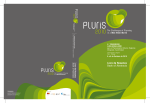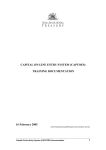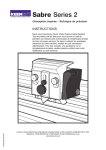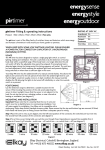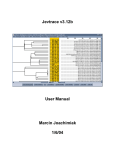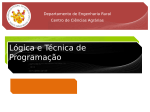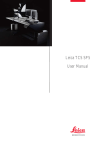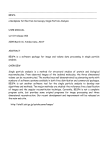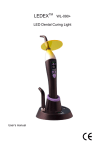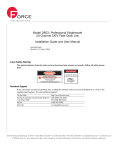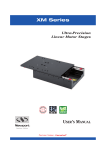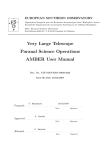Download Workstation for Laser Direct-Write Processing
Transcript
APPLICATION NOTE Workstation for Laser Direct-Write Processing 39 Technology and Applications Center Newport Corporation Introduction Lasers exhibit a number of features that makes them unique sources of energy for several material processing methods. For example, they are indispensable tools for drilling, welding, and cutting in industrial manufacturing where high average and peak powers are required. Furthermore, by virtue of their high spatial coherence, lasers can produce patterns with resolutions that extend over four orders of magnitude from millimeters to hundreds of nanometers. And lastly, materials can be removed, added, or modified without physical contact between a tool and the target substrate allowing rapid and inexpensive turnover. Any technique that uses a laser to create a pattern on the surface or in the volume of a material can be described as a laser direct-write (LDW) process.1 In LDW, the interaction between the laser and the material can create different effects: voids by means of ablation, material state modifications by means of thermal cycles, addition of diverse materials by means of chemical reactions or induced forward transfer procedures. LDW creates patterns in a “spot-by-spot” fashion where the target substrate is moved around a fixed laser beam and/or the laser beam is scanned following predetermined outlines. Although this serial approach to create parts is slow compared to more traditional parallel approaches, two characteristics of LDW methods render it attractive and competitive in many applications. First, there are almost no topological constraints for creating structures. Second, by choosing the appropriate laser and experimental conditions virtually any material can be processed. Examples of materials processed by LDW can be found among conductors, semiconductors, dielectrics, and ceramics.2 Both continuous wave and pulsed lasers have been successfully employed in LDW. In particular, the ones that have found the most uses thus far are infrared CO2 gas lasers, ultraviolet excimer gas lasers, and visible solid-state lasers. When interacting with these kinds of lasers, materials absorb light in a linear fashion and heating effects play an important role in the quality of the created patterns. If ultrashort (less than a picosecond) pulsed lasers are used for LDW, energy is deposited in the material in a time range shorter than the electron-phonon coupling time (a few picoseconds) rendering thermal effects negligible.3 Moreover, the likelihood to induce multiphoton absorption when using ultrashort pulsed laser is such that the matter/light interaction can be spatially confined to femtoliter volumes enabling high precision and high resolution (less that 100 nanometers) patterning. Consequently, LDW processes that use ultrashort pulsed lasers have found a large number of applications in fields diverse as microfluidics, photonics, MEMS, cell development, tissue engineering, and medicine.4 The purpose of this application note is to describe a workstation for LDW processing. Specific information on the components and their assembly will be outlined. Although 1 the workstation can be coupled with many lasers to achieve different LDW processes, we will show in particular how it can be used for two-photon polymerization by using an ultrashort pulse laser. Two-photon polymerization For a detailed description of two-photon polymerization (TPP) the reader is referred to Newport Application Note 37 “Three-dimensional Microfabrication by Two-photon Polymerization” (www.newport.com/TAC/AppsNote37). Briefly, in TPP, crosslinking of monomers is achieved by a radical chain reaction initiated by the simultaneous absorption of two photons. In order to enhance the probability of this event three conditions have to be met: the use of ultrashort pulsed lasers, the use of strongly focusing lenses, and the selection of an excitation wavelength in a spectral range where the photosensitive material possesses the largest two-photon cross-section. The main consequence of the optical nonlinearity of this process is the ability to confine polymerization within the focal volume of a tightly focused laser beam. If the photosensitive material can be solidified by two-photon absorption, three-dimensional microstructures with sub-micron resolution can be fabricated by means of accurate positioning of the laser focal point. As long as the solubility properties of the solidified and unsolidified material are different, the non-polymerized material can be washed away to leave the free-standing polymerized structures. TPP offers a unique combination of advantages. First, no topological constraints are present in the fabrication of three-dimensional structures. Second, sub-diffractionlimited resolution can be attained by employing laser intensities just above the intensity threshold at which polymerization will occur. Third, movable components can easily be fabricated without the use of sacrificial layers. Finally, the carbon based nature of the photosensitive materials can be used as a chemical handle to fabricate structures with tunable physical and chemical properties such as hardness, shrinkage, index of refraction and chemical specificity. TPP is a unique tool in the arsenal of unconventional microfabrication methods now available to researchers. This stems mainly from its ability to create three-dimensional microstructures of any geometrical complexity with a resolution smaller than 100 nm. While the main focus of research in TPP is in photonics, especially in the fabrication of three-dimensional photonic crystals,5 other areas of research are benefiting from TPP. For example, researchers in bioengineering and microelectronics are now able to create and use devices previously impossible to manufacture with conventional microfabrication procedures.6,7 Experimental setup Laser direct-writing by TPP can be performed by either moving the laser beam inside the sample or moving the sample around a fixed laser beam. In the first case, a set of Galvano-mirrors are used to scan the excitation beam in the x and y dimensions, while a piezo stage moves the sample or the objective up and down. In the second case, the sample is moved in all three dimensions with the aid of a three-axis stage. Although both techniques have proven to be effective, they have complementary advantages that have to be taken into consideration when choosing one system over the other. While galvos allow greater scanning speeds than a stage, the area they can pattern is limited by the objective's back aperture. On the other hand, the stage total travel distance is the only boundary that determines the maximum area of the sample that can be patterned resulting in processed areas many times larger than is possible with a set of galvos. In the workstation for LDW described in this application note, we have chosen the second approach. The laser beam is fixed and tightly focused through an objective lens into the sample which can be translated in all three dimensions with a stage assembly. A schematic of the setup is depicted in Figure 1. The light source is the Mai Tai® DeepSee™, a one-box Ti:sapphire based laser capable of producing pulses shorter than 100 fs with a repetition rate of 80 MHz. It provides 350 nm (690-1040 nm) of usable tuning range with a maximum output average power exceeding 3 watts at 800 nm (www.newport.com/MaiTai). Moreover, with the aid of automated dispersion compensation the Mai Tai DeepSee offers the highest peak power at the sample. With a dispersion compensation range of up to 40,000 fs2, it can easily offset the pulse broadening effect of high-numerical aperture objectives. CCD camera F L M M* S SF DM L L AC OL GLP HWP z XPS Controller x TS L F y Mai Tai DeepSee™ M WL-LED Figure 1 - Schematic of the laser direct-writing workstation. HWP, half-wave plate; GLP, Glan-laser polarizer; M, mirror; M*, beam sampler; AC, autocorrelator; S, shutter; L, lens; SF, spatial filter; DM, dichroic mirror; F, filter; OL, objective lens; TS, translational stages; WL-LED, white light LED. A half-wave plate (HWP) and a polarizer (GLP) are positioned after the oscillator and are used to variably attenuate the laser output power to the desired input power required by specific experiments (www.newport.com/AppsNote26). Using a beam sampler (M*), a small portion of the laser beam is directed into a beam diagnostic unit (AC). The laser pulse is characterized both in the time and frequency domains by employing an autocorrelator and a spectrometer (www.newport.com/pulsescout). The laser beam is then expanded to match or overfill the back aperture of the objective. This is accomplished using two positive lenses with the appropriate focal lengths. At the focal point of the first lens, a pinhole (SF) is carefully positioned to spatially filter the beam. This assembly can be greatly simplified by using a modular spatial filter/laser beam expander which is built around a rail system. It provides high resolution positioning and maximum flexibility for experiments that require different laser beam diameters (www.newport.com/SFBE). An electromechanical shutter (S), used to control laser exposure times in the sample, is placed before this assembly. A dichroic mirror (DM), which is reflective for near-IR and transparent for visible radiation, deflects the laser beam into an infinity corrected objective (OL) that focuses the excitation light into the sample. In all experiments shown in this application note, a 40X 0.75NA objective was employed. The position of the sample in the objective field of view is adjusted by the aid of a three axis computer-controlled stage (TS). The stage assembly of this workstation consists of three units stacked one on top of the other. For the x and y directions, two XMS50 (www.newport.com/stages/XMS) linear stages are used while for the z direction, a VP-5ZA (www.newport.com/stages/VP-5ZA) vertical stage is used. The XMS50’s are high performance stages with minimum incremental motion, repeatability, and accuracy of 10 nm, 80 nm, and 200 nm respectively. These features hold true along the entire 50 mm travel range of the stage (two other versions of the stage are available with travel ranges of 100 and 160 mm). Because the XMS50 stages employ a frictionless direct drive linear motor, heat generation is greatly diminished allowing ultra-precise motion. The workstation described allows for real-time monitoring of the area of the sample being processed by the laser. This is accomplished by assembling a basic microscope. The main components are a source of visible light, a CCD camera, a video screen, and few optics. An excellent source of light is the Oriel® white light LED (WL-LED); it is compact with a high intensity light source that can be easily and variably attenuated through its driver. It comes with several attachments for easy integration with standard optical parts (www.newport.com/LED). 2 When performing TPP, it is important to remember to cover the light source with a short-pass optical filter (F) in order to prevent the blue part of the lamp emission spectrum from causing any undesired polymerization in the photoresist. Furthermore, a long-pass optical filter (F) is placed in front of the CCD camera to prohibit laser backreflections to reach and saturate the pixels of the camera. The ability to image the sample while performing TPP is an important feature for a successful fabrication process. It is of utmost importance to anchor the microstructures to the substrates if they are to survive the washing step of the unsolidified resin. The way to ensure this is to start TPP exactly at the interface between the substrate and the resin, a task easily achieved with the above described realtime monitoring. A schematic of the sample assembly employed in the TPP is shown in Figure 2. The resin is sandwiched between two microscope cover slips. The thickness of the film is determined by the thickness of the spacer. If microfabrication starts at the resin/substrate interface furthest from the laser entrance, it is imperative to use a spacer thin enough to account for the limitation of the working distance of the objective lens. In raster-scan mode, a cube element is scanned into the photoresist and the structure is formed inside the cube by opening and closing the shutter only where the volume of the structure intersects that of the cube. In vector-scan mode, the shutter remains open while the focused laser traces the profile of the microstructure. Thus, for a defined structure the vector-scan mode leads to shorter processing times than the raster-scan one since it needs to outline only the surface of the object. In TPP though, not all structures can be fabricated by vector-scan mode. If the ratio of volume to surface is too big, shrinkage of the unsolidified material inside the microstructure can significantly alter its shape over time. A screen-shot of the software main front panel is shown in Figure 3. The structure of interest is first defined by its geometry and dimensions and subsequently saved as a text file by using the “Polygon” tab. In this file, coordinates that will be followed by the stages to write the predetermined geometry are encoded in a set of four columns each representing starting and ending points for movements in the x and y axes. A fifth column of numbers is reserved for coordinates in the z direction. Prior to fabrication, the file can be examined and eventually manipulated employing the “Image Manipulation” tab. Next, the structure can be fabricated by uploading the text file in the “Run” tab and defining the velocity and acceleration for the stages. Fabrication can be accomplished in either absolute or relative positions. For example, the file represented in Figure 3 is used for the fabrication of a truncated cone with hexagonal cross section. This is accomplished by stacking in the z direction hexagonal patterns with smaller and smaller sides. In order to create such a structure it is important to know the size of the voxel (smallest polymerized volume element) achievable under the experimental conditions. Only by overlapping voxels properly, free-standing three-dimensional microstructures can be attained. Figure 2 - Schematic of the sample assembly used in TPP. The trajectories of the stages and the activity of the shutter are operated through the XPS controller/driver (www.newport.com/XPS). The XPS is a high performance controller with the capability of driving eight actuators and stages, both linear and rotary. It possesses extensive analog I/O functionalities and permits the operator to choose among a wide variety of motion modes such as point-to-point, line-arc trajectories, and velocity profiling. Software written in LabVIEW® is used to run the workstation through the XPS by synchronizing the movement of the three stages with the action of the shutter. Through this software, the operator can choose between two modes for three-dimensional microfabrication by TPP, raster-scan or vector-scan mode. 3 A convenient feature of this software is its ability to control the stages in a joystick-like fashion. This is quite useful when patterning areas larger than the objective lens field of view. With the shutter closed, it allows for quick monitoring of the entire sample. The part of the workstation that consists of the stages, the shutter, and the imaging setup is assembled on two 24” x 24” aluminum plates held perpendicular with respect to each other by means of a heavy-duty rod system. A picture of this part of the workstation is shown in Figure 4. Since the laser beam has been expanded to around 8 mm in diameter at this point (in order to overfill the back aperture of the 40x 0.75NA objective lens), two elliptical broadband metallic mirrors are used to steer it to the appropriate height. Finally, the dichroic mirror reflects the beam into the sample through the objective lens. The objective lens is mounted on a manual translational stage to enable easy sample loading and course focus adjustment. right conditions for best imaging, the focusing lens and the CCD camera are attached to carriers that can glide up and down on high precision rails. Two- and three-dimensional patterning by two-photon polymerization The workstation for LDW so far illustrated was utilized for fabricating two- and three-dimensional microstructures by TPP. Several chemical formulations have been demonstrated to be efficient photosensitive materials for TPP. The one employed in this application note is fully described in reference 8 and consists of a radical photoinitiator and two highly branched acrylate monomers. Figure 3 - Front panel of the software used to run the laser direct-writing workstation. As an example, a file employed to fabricate a hexagonal shaped pyramid by TPP is shown. Upon TPP, the photosensitive material undergoes a change of state from liquid to solid. The two states have different densities and hence different indices of refraction (n 0.03 for the resin used in this study). It is this difference that facilitates contrast imaging. In order to increase sensitivity, imaging is accomplished by white light illumination in transmission mode. By using files similar to the one shown in Figure 3, two cones with square cross-sections possessing different aspect ratios were fabricated on a glass substrate (Figure 5). For both structures, stage velocities of 10 µm/s were selected and xy layers were stacked in the z direction with 2 µm separation. The laser average powers used for fabricating the smaller and larger cones were 6 mW and 10 mW respectively, as measured with a photodiode detector after the shutter. While the smaller cone shows signs of distortion due to the solvent used to wash away the unsolidified part of the resin, the larger cone maintained the straight features of the original design. The different energy doses used in the fabrication of the cones lead to a slight difference in the amount of polymer crosslinking, producing materials with dissimilar mechanical properties. On the same substrate, two smaller cones with hexagonal cross-sections were fabricated and their tops connected by a 40 µm long and 5 µm wide suspended bridge. The bridge was created by carefully overlapping 5 µm long polymerized lines along its entire length. The same experimental conditions used for fabricating the larger cone were also used for this multi-featured structure. Figure 4 - Photograph of a part of the laser direct-writing workstation. The red line and the yellow shadow have been graphically added to guide the eye through the excitation and imaging paths respectively. S, shutter; M, mirror; DM, dichroic mirror; OL, objective lens; WL-LED, white light LED; X, Y, and Z stages. A lens is used to collimate the white light produced by the LED and a yellow filter is used to cut off the shorter part of its emission spectrum. These optical elements are contained in Newport Oriel® filter holders that can be installed directly at the exit aperture of the light source. A metallic mirror (M) mounted at 45º directs the illumination through the sample and a short focal lens (25.4 mm) acts as a condenser. The transmitted light travels through the objective and the dichroic mirror and is imaged on the active area of the CCD camera with a 100 mm focal length lens. The focusing lens is assembled on top of the dichroic mirror and its proper position relative to the CCD camera is essential for sharp imaging. In order to have a simple and flexible way to find the Figure 5 - Scanning electron microscopy image of three microstructures fabricated by TPP. The sample was tilted 45º in order to reveal the three-dimensional nature of the microstructures. The scale bar is 20 µm. 4 The ultimate resolution of three-dimensional microfabrication by TPP depends upon factors influencing the voxel size. These are the wavelength of the laser beam used to induce two-photon absorption, the numerical aperture of the objective used to focus the laser beam into the sample, and the laser energy dose. The latter is controlled by adjusting the laser average power and exposure time. Although shorter wavelengths will form smaller voxels, the choice of the excitation energy is dictated mainly by the photoinitiator efficiency. In general, the working wavelength of choice optimizes the product of the photoinitiator twophoton cross-section area and quantum yield for radical generation. Therefore, experimentally it is most common to increase resolution by employing high NA objectives (1.4) and laser intensities near the threshold for polymerization. By carefully selecting these conditions, features smaller than 100 nm were fabricated by TPP.9 Figure 6 is a scanning electron microscopy (SEM) image of wires polymerized by TPP suspended in air by means of two towers 10 µm tall. The two wires were fabricated by a single laser pass at a velocity of 40 µm/s. The laser average power was 10 mW. A top view was chosen in order to measure precisely the width of the wires that resulted to be 480 nm. Considering that the numerical aperture of the objective used in this experiment is less than one (0.75), the achieved lateral resolution is an encouraging sign for patterning large areas with high precision. pre-existing structures. In order to show how the LDW workstation described in this application note could achieve this accuracy, we performed composite patterning of two different materials by TPP. Two resins were prepared, one doped with Rhodamine B (resin 1) and the other doped with Coumarin 334 (resin 2). Rhodamine B and Coumarin 334 are fluorophores that when excited, emit a broad fluorescence with maximum intensities at 610 nm and 500 nm, respectively. First, microstructures were fabricated by TPP on a glass substrate using resin 1. A series of reference markers were also fabricated in key locations. Then, after washing away the unsolidified part of resin 1, resin 2 was poured onto the substrate. A second set of microstructures were fabricated by TPP in pre-defined locations relative to the microstructures fabricated with resin 1 by visually locating the markers. Figures 7 and 8 show the results of these experiments. For each microstructure two imaging modalities were used, SEM and confocal microscopy. While detailed information on size and surface topology can be gathered from analysis of the SEM image, no indication of the different nature of materials is revealed. By using the appropriate excitation light sources and collection filters, the confocal microscopy images exposes which elements of the pattern were made with resin 1 and which ones with resin 2. The structure depicted in Figure 8 was fabricated by arranging in a grid pattern vertical 120 µm long polymer bars made with resin 1 and horizontal 100 µm long polymer bars made with resin 2. Both polymer bars are 4 µm wide and were obtained by overlapping several laser passes. The text NEWPORT in Figure 7 was fabricated by alternating letters made of resin 1 and 2. Each letter is 20 µm wide and 25 µm long. Although the spaces left between the first set of letters were only 30 µm wide, the high accuracy of the stages in the workstation allowed for precise “writing” of the remaining letters. Identical experimental conditions were used for the fabrication of both microstructures in Figures 7 and 8; 10 µm/s stage velocities and 9 mW of average laser power. Figure 6 - Scanning electron microscopy image of wires fabricated by TPP. They are anchored to square shaped towers and suspended at a height of 10 µm. In creating patterns by TPP, it would be desirable to deposit on the same substrate, materials with different mechanical and/or optical properties. This could lead to microstructures with “smart” features such as diverse responses to external stimuli. A crucial element for the success of this microfabrication approach would be the accuracy with which different materials can be patterned relative to the position of 5 Figure 7 - SEM (a) and confocal microscopy (b) images of the word NEWPORT fabricated by TPP. The red and blue letters in (b) correspond to resins doped with Rhodamine B and Coumarin 334 respectively. The scale bar is 20 µm. References 1. Arnold, C. B., Pique', A., MRS Bulletin, 32, 9 (January 2007). 2. Chrisey, D. B., Science, 289, 879, (2000). 3. Cahill,D. G., Yalisove, S. M., MRS Bulletin, 31, 594, (August 2006). 4. Gattass, R. R., Mazur, E., Nature Photonics, 2, 219, (2008). 5. Sun, H. B., Matsuo, S., Misawa H., Appl. Phys. Lett., 74, 786(1999). 6. Tayalia, P., Mendonca, C. R., Baldacchini, T., Mooney, D. J., Mazur E., Adv. Mat., 20, 4494, (2008). 7. Farrer, R. A., LaFratta, C. N., Li, L., Praino, J., Naughton, M. J., Saleh, B.E.A., Teich, M.C., Fourkas, J. T., JACS 128, 1796, (2006). 8. Baldacchini, T., LaFratta, C. N., Farrer, R. A., Teich, M. C., Saleh, B. E. A., Naughton, M., Fourkas, J. T., J. Appl. Phys., 95, 6072, (2004). 9. Takada, K., Sun, H. B., Kawata, S., Appl. Phys. Lett. 86, 071122 (2005). Figure 8 - SEM (a) and confocal microscopy (b) images of a reticle fabricated by TPP. The red and blue lines in (b) correspond to resins doped with Rhodamine B and Coumarin 334 respectively. The scale bar is 30 µm. Conclusions We described a workstation for laser direct-writing based on Newport high performance stages. With a collection of several optical and mechanical components and optimized software, this workstation is a flexible tool for creating twoand three-dimensional structures with submicron resolution. Furthermore, large areas can be patterned by taking advantage of the total travel range of the stages. As an example, we have illustrated how this workstation can effectively perform two-photon polymerization when used in combination with a femtosecond Ti:sapphire laser. More generally, the setup described in this application note is capable of prototyping parts for devices with potential use in fields such as photonics, microelectronics, and bioengineering. 6 Newport Corporation Worldwide Headquarters 1791 Deere Avenue Irvine, CA 92606 (In U.S.): 800-222-6440 Tel: 949-863-3144 Fax: 949-253-1680 Email: [email protected] Visit Newport Online at: www.newport.com This Application Note has been prepared based on development activities and experiments conducted in Newport’s Technology and Applications Center and the results associated therewith. Actual results may vary based on laboratory environment and setup conditions, the type and condition of actual components and instruments used and user skills. Nothing contained in this Application Note shall constitute any representation or warranty by Newport, express or implied, regarding the information contained herein or the products or software described herein. Any and all representations, warranties and obligations of Newport with respect to its products and software shall be as set forth in Newport’s terms and conditions of sale in effect at the time of sale or license of such products or software. Newport shall not be liable for any costs, damages and expenses whatsoever (including, without limitation, incidental, special and consequential damages) resulting from any use of or reliance on the information contained herein, whether based on warranty, contract, tort or any other legal theory, and whether or not Newport has been advised of the possibility of such damages. Newport does not guarantee the availability of any products or software and reserves the right to discontinue or modify its products and software at any time. Users of the products or software described herein should refer to the User’s Manual and other documentation accompanying such products or software at the time of sale or license for more detailed information regarding the handling, operation and use of such products or software, including but not limited to important safety precautions. This Application Note shall not be copied, reproduced, distributed or published, in whole or in part, without the prior written consent of Newport Corporation. Copyright ©2009 Newport Corporation. All Rights Reserved. Spectra-Physics®, the Spectra-Physics “S” logo, the Newport “N” logo, and Mai Tai® are registered trademarks of Newport Corporation. Newport™ and Deep See,™ are trademarks of Newport Corporation. LabVIEW® is a registered trademark of National Instruments, Inc. Newport Corporation, Irvine, California, has been certified compliant with ISO 9001 by the British Standards Institution. MM#90000099 DS-12084








